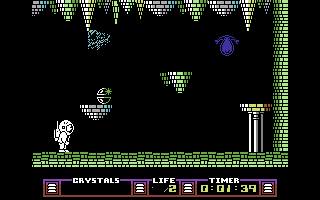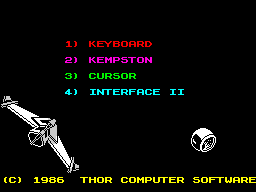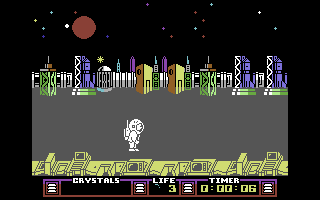Retro Replay Review
Gameplay
The Arc of Yesod builds directly on the mechanics introduced in its predecessor, Nodes of Yesod, but refines them into a more focused and challenging experience. Players take control of Charlie, navigating through sprawling cave networks on the alien world of Ariat. Exploration is at the heart of the game, with each cavern branching in multiple directions and hiding both dangers and rewards. As you search for the eight crystals needed to destroy the monolith, you’ll find yourself memorizing layouts, marking safe routes, and planning daring dashes through enemy-infested corridors.
Central to combat is the sphere-launching device, which Charlie can deploy by pressing up on the joystick. This clever mechanic lets you detach a floating orb that you guide independently of your character, creating tense moments as you maneuver the projectile through narrow passageways and around hostile creatures. It’s a satisfying solution to ranged attacks on a side-scroller, but it demands patience and precision: misjudging speed or trajectory often means losing precious health or crystals to an unexpected foe.
Enemies in The Arc of Yesod range from simple crawling insects to hulking mutants and the notorious spacemen who steal crystals upon contact. Some adversaries are immune to your sphere and require careful avoidance or strategic luring into hazards. Transporters dotted throughout the levels add further complexity, whisking you to hidden alcoves or secret tunnels—but they can also dump you unprepared into high-pressure fights. This interplay of risk versus reward keeps the gameplay loop fresh and encourages both cautious exploration and spur-of-the-moment improvisation.
Despite its age, the control scheme feels responsive, and the level design strikes a solid balance between linear progression and non-linear discovery. Checkpoints are thankfully placed at regular intervals, though death often means replaying tricky segments to recover lost crystals. For players who relish methodical puzzle-solving blended with arcade-style shooting, The Arc of Yesod offers dozens of hours of engrossing gameplay and the satisfaction of slowly mastering its subterranean challenges.
Graphics
Visually, The Arc of Yesod captures a moody, alien atmosphere through its palette of muted purples, blues, and grays. The cavern walls are textured with subtle gradients, hinting at mineral veins and otherworldly formations. You’ll often find yourself in near-darkness, relying on soft glows around crystals or the luminescent orb to pierce the gloom. This graphical approach not only reinforces the sense of exploration but also heightens tension each time you round a corner.
Sprite animations are fluid for a game of its era, with Charlie’s idle stance, walking cycle, and firing posture all rendered crisply. Enemies move with distinctive patterns: the creeping spider variably skitters along floors and ceilings, while larger creatures lumber slower but deliver devastating contact damage. Seeing your orb ricochet off walls and hurtle toward a target never loses its appeal, especially when pixel-perfect aim is required to take down a particularly elusive foe.
Background details, such as distant rock stalactites or softly pulsing alien flora, add depth without overwhelming the action. Parallax scrolling is modest yet effective, giving each cavern a layered feel as you traverse foreground ledges or peer down into lower tunnels. While The Arc of Yesod doesn’t boast the high-color sprites of later titles, its art direction and clever use of hardware limitations create a unified, immersive world that still holds up for players seeking retro charm.
The user interface remains unobtrusive: a small status bar displays your remaining crystals and lives without intruding on the play area. Pop-up notifications for crystal collection or damage are clear and immediate, ensuring you’re always aware of your objectives and peril. In combining atmospheric backdrops with well-crafted animations, The Arc of Yesod delivers a presentation that both respects its roots and stands out on vintage hardware.
Story
The narrative in The Arc of Yesod picks up after the events of Nodes of Yesod, weaving a tight continuation rather than a standalone pretext. Your mission to destroy the monolith was thwarted on the moon, and now the alien monolith has been returned to its creators, the Ariatans, on the planet Ariat. As Charlie, a lone astronaut-hero, you are humanity’s last hope to prevent a data transfer that could compromise Earth’s security.
Even though much of the story unfolds through simple text messages before and after key levels, the premise provides a compelling motivation for your underground crusade. Discovering terminal points that reveal snippets of Arian secrets or finding audio logs embedded in monolithic fragments enriches the tale without breaking gameplay flow. These story elements create a sense of urgency and curiosity: what exactly does the monolith contain, and how far will the Ariatans go to retrieve every bit of information?
Character development is sparse but purposeful. Charlie’s stoic determination is conveyed through his lone silhouette against cavernous expanses, suggesting both isolation and courage. The Ariatans remain enigmatic antagonists, their monolithic engineering speaking volumes more than any spoken dialogue. This minimalist storytelling approach suits the game’s exploratory nature, letting players fill gaps with their own imagination as they piece together the cosmic stakes.
Ultimately, The Arc of Yesod uses its storyline to frame each exploratory segment, giving context to every crystal found and enemy defeated. While you won’t get lengthy cutscenes or voiceovers, the narrative beats strike a satisfying balance: just enough lore to invest you in Charlie’s quest, but never so much that it derails the central gameplay experience.
Overall Experience
The Arc of Yesod delivers a finely tuned blend of exploration, puzzle-solving, and action that remains engaging decades after its release. Its balance of atmospheric tension and arcade thrills makes each cavern feel like a miniature adventure, where a single misstep can force you to start again but mastering a segment brings genuine satisfaction. Whether you’re a retro aficionado or a newcomer to vintage side-scrollers, the game’s design rewards patience and skill.
Sound design, though not a separate heading here, plays an important role in setting the mood. Sparse background tones, echoed beeps upon crystal pickup, and the distinctive “whoosh” of your orb all contribute to a cohesive audio landscape. It’s minimalist but effective, ensuring you never lose track of your surroundings or impending dangers. The occasional ambient hum or distant creature screech adds to the sense that you’re far from Earth, deep in alien territory.
Revisiting The Arc of Yesod today may feel challenging—crystal-hunting games of its era rarely held the player’s hand. Still, perseverance reveals hidden pathways, secret rooms, and the true layout of Ariat’s caverns. For collectors and nostalgic gamers, it’s a chance to witness an early example of atmospheric platform design, while newcomers will appreciate the game’s straightforward yet deep mechanics.
In sum, The Arc of Yesod stands as a testament to creative gameplay built around simple but inspired concepts. Its blend of moody visuals, tight controls, and layered level design offers an experience that’s both demanding and deeply rewarding. If you’re looking for a game that challenges you to think strategically about every step and shot, Charlie’s mission on Ariat should not be missed.
 Retro Replay Retro Replay gaming reviews, news, emulation, geek stuff and more!
Retro Replay Retro Replay gaming reviews, news, emulation, geek stuff and more!









Reviews
There are no reviews yet.